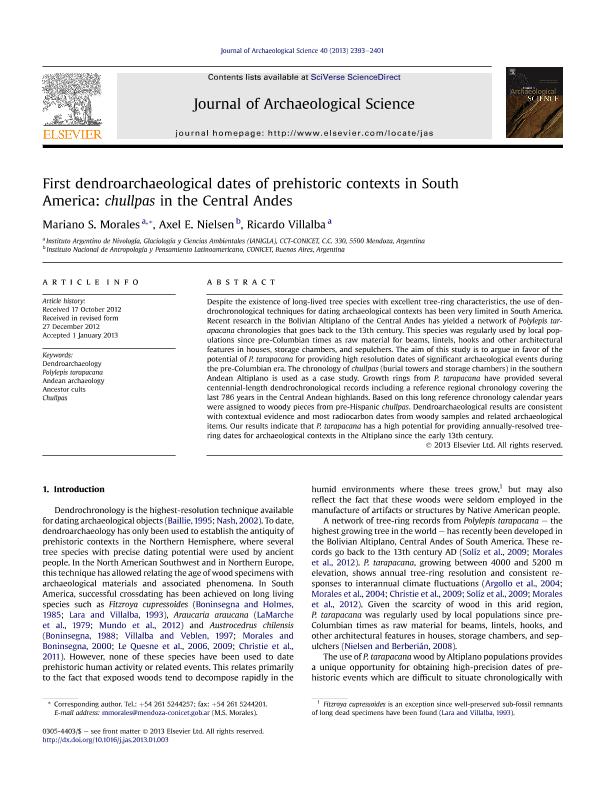Mostrar el registro sencillo del ítem
dc.contributor.author
Morales, Mariano Santos

dc.contributor.author
Nielsen, Axel Emil

dc.contributor.author
Villalba, Ricardo

dc.date.available
2016-12-26T14:49:17Z
dc.date.issued
2013-04
dc.identifier.citation
Morales, Mariano Santos; Nielsen, Axel Emil; Villalba, Ricardo; First dendroarchaeological dates of prehistoric contexts in South America: chullpas in the Central Andes; Elsevier; Journal Of Archaeological Science; 40; 5; 4-2013; 2393-2401
dc.identifier.issn
0305-4403
dc.identifier.uri
http://hdl.handle.net/11336/10079
dc.description.abstract
Despite the existence of long-lived tree species with excellent tree-ring characteristics, the use of dendrochronological techniques for dating archaeological contexts has been very limited in South America. Recent research in the Bolivian Altiplano of the Central Andes has yielded a network of Polylepis tarapacana chronologies that goes back to the 13th century. This species was regularly used by local populations since pre-Columbian times as raw material for beams, lintels, hooks and other architectural features in houses, storage chambers, and sepulchers. The aim of this study is to argue in favor of the potential of P. tarapacana for providing high resolution dates of significant archaeological events during the pre-Columbian era. The chronology of chullpas (burial towers and storage chambers) in the southern Andean Altiplano is used as a case study. Growth rings from P. tarapacana have provided several centennial-length dendrochronological records including a reference regional chronology covering the last 786 years in the Central Andean highlands. Based on this long reference chronology calendar years were assigned to woody pieces from pre-Hispanic chullpas. Dendroarchaeological results are consistent with contextual evidence and most radiocarbon dates from woody samples and related archaeological items. Our results indicate that P. tarapacana has a high potential for providing annually-resolved tree-ring rates for archaeological contexts in the Altiplano since the early 13th century.
dc.format
application/pdf
dc.language.iso
eng
dc.publisher
Elsevier

dc.rights
info:eu-repo/semantics/openAccess
dc.rights.uri
https://creativecommons.org/licenses/by-nc-nd/2.5/ar/
dc.subject
Dendroarchaeology
dc.subject
Polylepis Tarapacana
dc.subject
Andean Archaelogy
dc.subject
Ancestor Cuits
dc.subject.classification
Arqueología

dc.subject.classification
Historia y Arqueología

dc.subject.classification
HUMANIDADES

dc.title
First dendroarchaeological dates of prehistoric contexts in South America: chullpas in the Central Andes
dc.type
info:eu-repo/semantics/article
dc.type
info:ar-repo/semantics/artículo
dc.type
info:eu-repo/semantics/publishedVersion
dc.date.updated
2016-09-19T18:47:52Z
dc.journal.volume
40
dc.journal.number
5
dc.journal.pagination
2393-2401
dc.journal.pais
Países Bajos

dc.journal.ciudad
Amsterdam
dc.description.fil
Fil: Morales, Mariano Santos. Consejo Nacional de Investigaciones Científicas y Técnicas. Científico Tecnológico Mendoza. Instituto Argentino de Nivología, Glaciología y Ciencias Ambientales; Argentina
dc.description.fil
Fil: Nielsen, Axel Emil. Secretaría de Cultura de la Nación. Dirección Nacional de Cultura y Museos. Instituto Nacional de Antropología y Pensamiento Latinoamericano; Argentina
dc.description.fil
Fil: Villalba, Ricardo. Consejo Nacional de Investigaciones Científicas y Técnicas. Científico Tecnológico Mendoza. Instituto Argentino de Nivología, Glaciología y Ciencias Ambientales; Argentina
dc.journal.title
Journal Of Archaeological Science

dc.relation.alternativeid
info:eu-repo/semantics/altIdentifier/url/http://www.sciencedirect.com/science/article/pii/S0305440313000101
dc.relation.alternativeid
info:eu-repo/semantics/altIdentifier/url/http://dx.doi.org/10.1016/j.jas.2013.01.003
Archivos asociados
